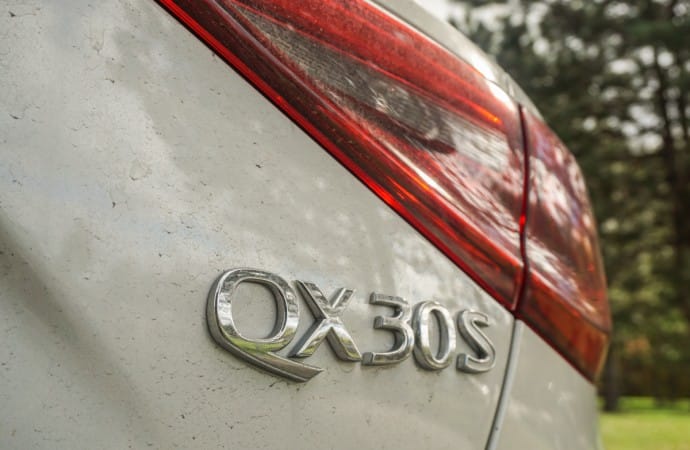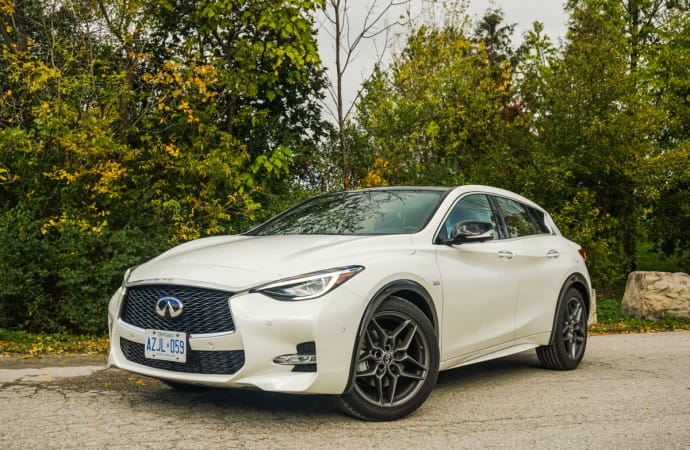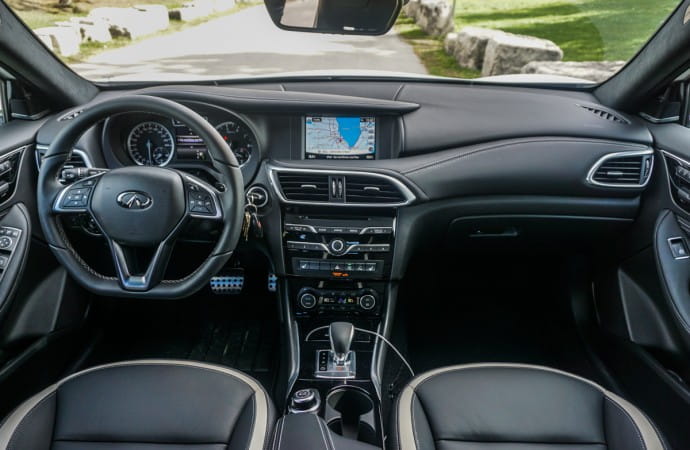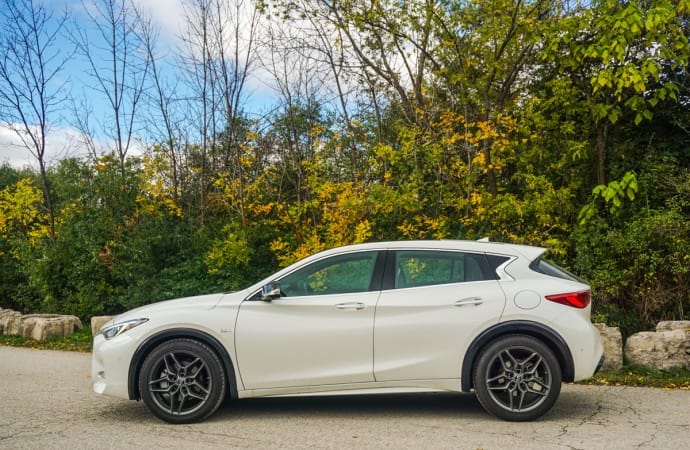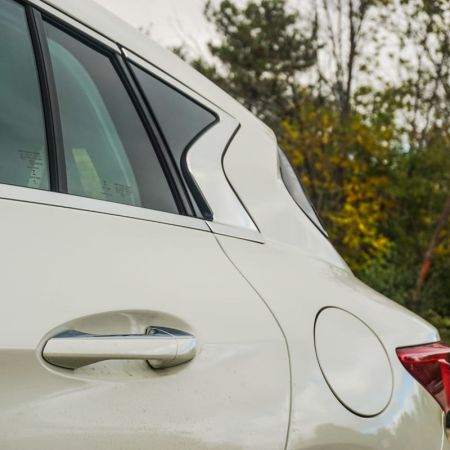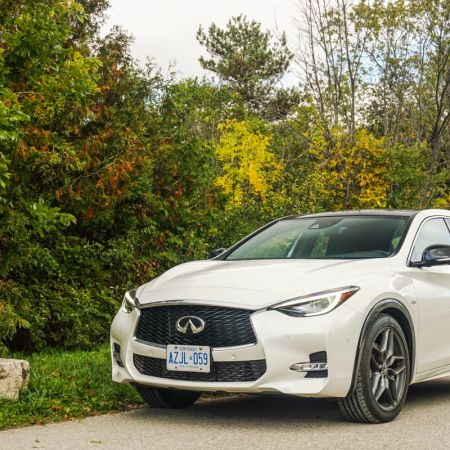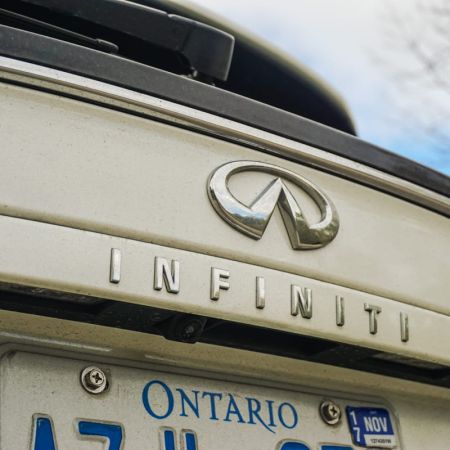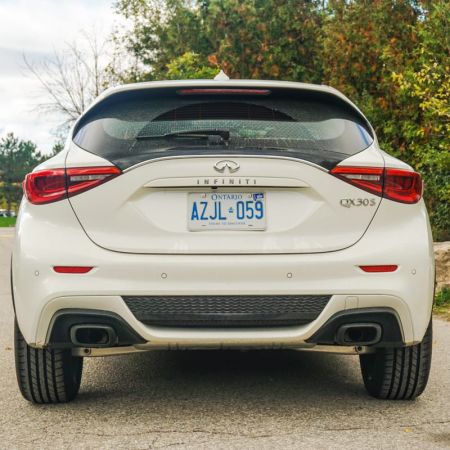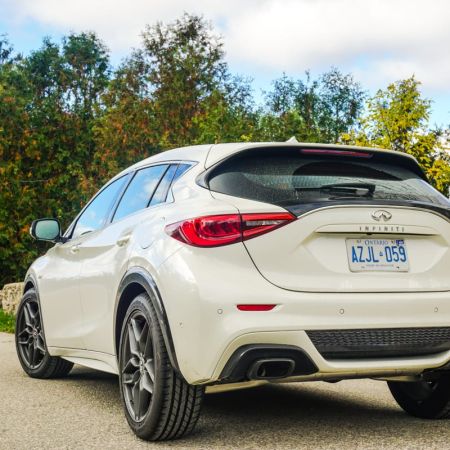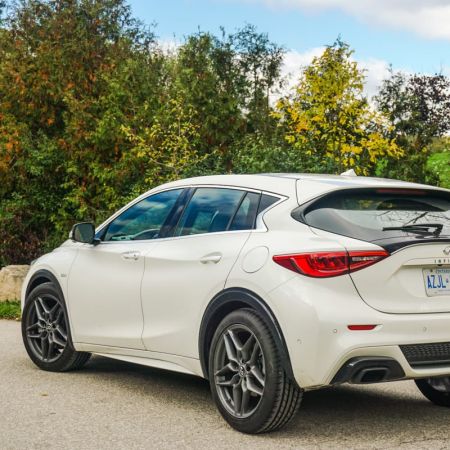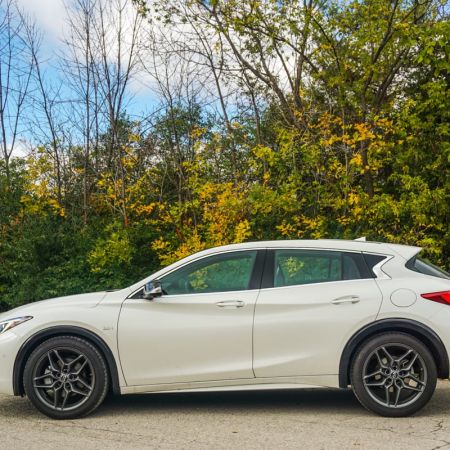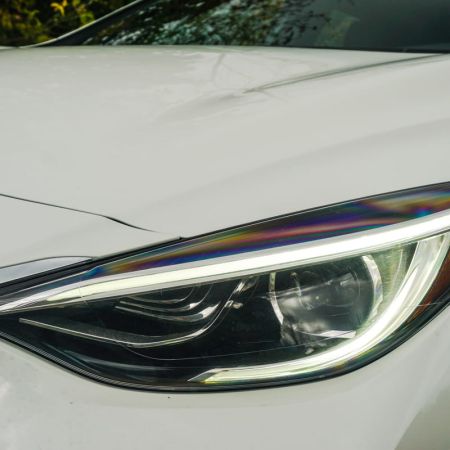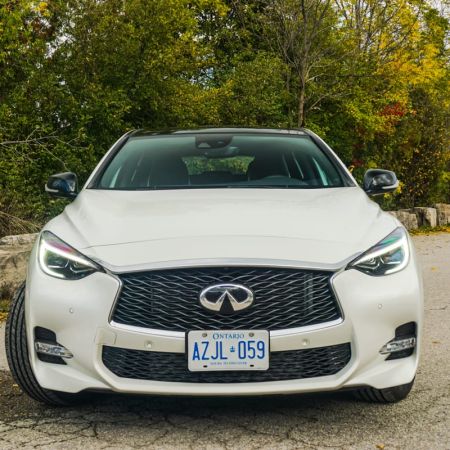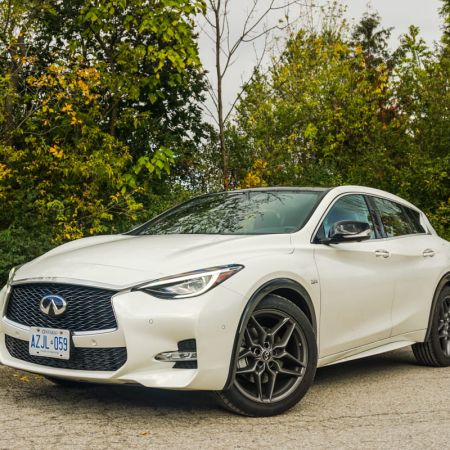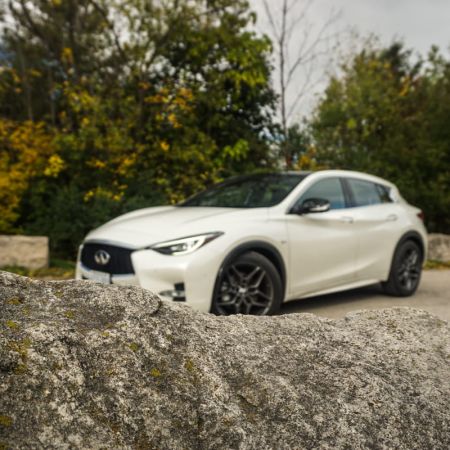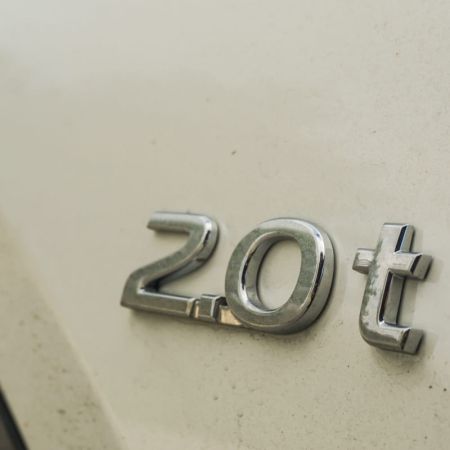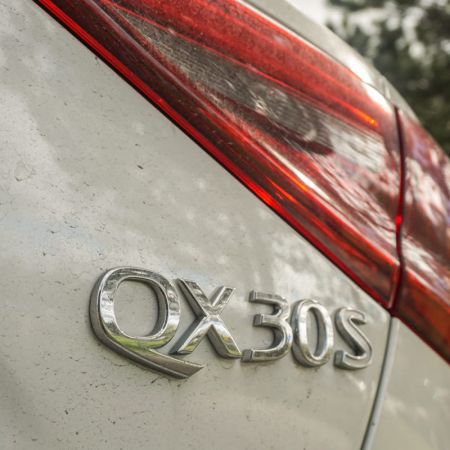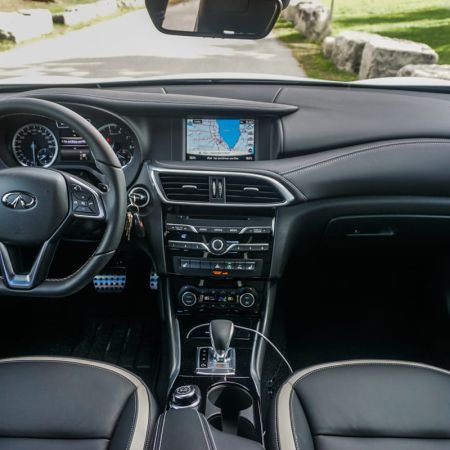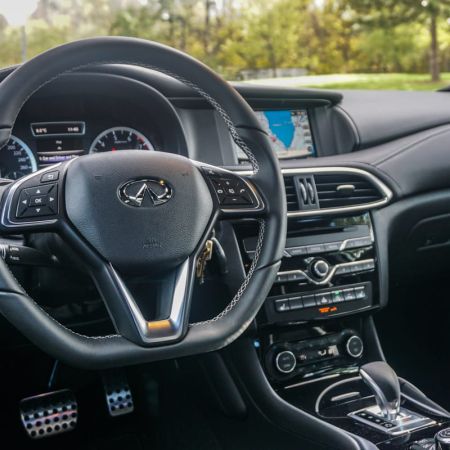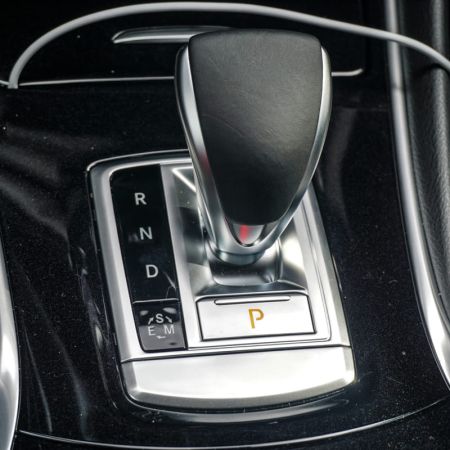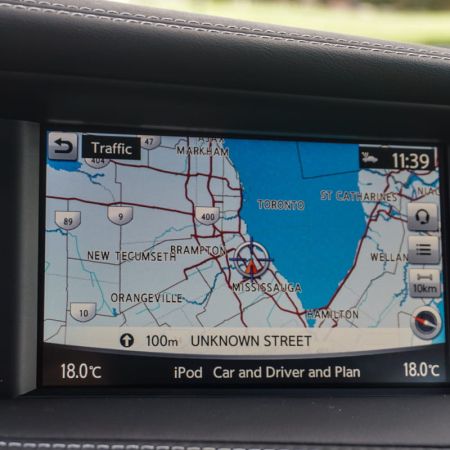Infiniti has been doing pretty well at producing some wicked new cars. The just-introduced Q60 coupé is stunning, and the QX50 (reviewed here) is one of the most engaging luxury crossovers currently available. The latest crossover in their lineup is a bit smaller – something to target the Audi Q3 (reviewed here) and the Mercedes-Benz GLA. Intriguingly, a brand partnership with one of these very brands has resulted in the birth of this new baby in the Infiniti family. We were tossed the keys to a 2017 Infiniti QX30 Sport, in its highest available trim, painted in a Majestic White.
As I first laid eyes upon the new QX30, with its striking Infiniti fascia, bright LED headlights and unmistakable Infiniti waves in the side profile, I started seeing the profile of something we tested just last year. The Mercedes-Benz GLA (reviewed here) is the basis for this vehicle, and this is blatantly obvious as the QX30 is the only Infiniti to use a Mercedes-Benz key (with the three-pointed star replaced by the Infiniti logo). The good folks at Infiniti say this is a “premium active crossover”, which allows buyers to get into the luxury brand at a lower entry price.
Power for the QX30 comes from a 2.0L turbocharged and direct-injected inline four-cylinder engine sourced from Mercedes-Benz. It puts out 208 horsepower at 5,500RPM and 258 lb-ft of twist at just 1,200RPM. Power is sent to the front wheels on the Sport trim via a seven-speed dual-clutch transmission with paddle shifters. It’s not a particularly fast car, certainly not up to the 355-horse GLA 45 AMG, but the QX30 gets out of its own way. The 2.0T is the only available engine on the QX30, and while it’s the one the typical buyer will be very happy with, it would be interesting to see some sort of Red Sport variant of this little thing in the future.
Something that really surprised me about the Infiniti is the steering. It feels tight and responsive, pulling the car in and out of corners with no problems whatsoever. Being front-wheel-drive, the QX30 still displays a good amount of understeer, which is no surprise. The Sport’s dampers and springs are all Infiniti, which maintain refinement in corners and deliver decent ride quality on all road surfaces we sampled. The 19” wheels do make for a harsher ride, but this is to be expected when paying a premium for the sportier trim.
For a 2.0L turbocharged four, fuel economy on the highway surprised us. Running on strictly premium fuel, we averaged 9.0L/100km over a 450km test week, with a lot of city driving and traffic included in the mix. A longer highway run across the city late at night, when no traffic was present, resulted in 7.3L/100km. One thing this seven-speed DCT is good at is holding seventh gear unless the accelerator is depressed enough to absolutely require a downshift. There’s sufficient power to pass most traffic without this move, typically.
After spending some time inside the new QX30, it became prominent just how much of a Mercedes-Benz this thing still is. The switchgear, materials, and plenty of the electronics are still Benz parts, with the exception of the infotainment, which is an Infiniti unit (thank god, because the Mercedes one in the GLA is quite dated now). The controller for the system is located in the same spot as it is on the GLA, but it’s the Infiniti controller (as seen on the new Q50 reviewed here). Bluetooth connectivity is flawless, and the one USB port is also compatible with plenty of different devices.
The QX30 Sport uses different, sportier seats than the regular models. These have fixed headrests and added bolstering for spirited driving. They’re fairly comfortable, though the rear seats leave a lot to be desired. The raked roofline of the QX30 also gets in the way of rear headroom, and at 6’1 I can only dream of comfort in the rear. The sport-tuned suspension resulted in rear passengers complaining a bit about bounciness on regular streets, though this wasn’t a concern out on the highway. The rear cargo area will hold an unpredicted amount of luggage, though the non-powered liftgate is unusually heavy to lower and may be cause for concern for some buyers. The option for a power liftgate on the Sport model is something we would like to see in coming years.
Infiniti was really serious about the low cost of entry, because the base front-drive QX30 starts at $35,990. Stepping up to the QX30 AWD is $38,490, and the AWD can be optioned with the Premium Package and the Technology Package, which add up to $7,500 to the sticker. This Sport is $46,490 and includes the Technology Package as standard equipment. This includes the complete set of driver aids, along with Infiniti Around View Monitor and intelligent cruise control. It’s pretty affordable, and right in line with the Audi Q3 (reviewed here), but we would have liked to see all-wheel-drive available on this trim as well.
The entry-level luxury crossover market has a few interesting entries, the Audi Q3 being the runaway style champion. The 2017 Infiniti QX30 Sport is a fresh face, with plenty of design cues inferring it’s a bit more expensive than its price would suggest, and a futuristic fascia. If anything, it’s a slick little choice that will swallow up a good amount of cargo (including strollers), considerably more than the Mazda CX-3 (reviewed here) will hold. Small families or urban couples who prioritize slick looks and a modern interior will find themselves right at home in Infiniti’s latest.
2017 Infiniti QX30 Sport Gallery
See Also:

